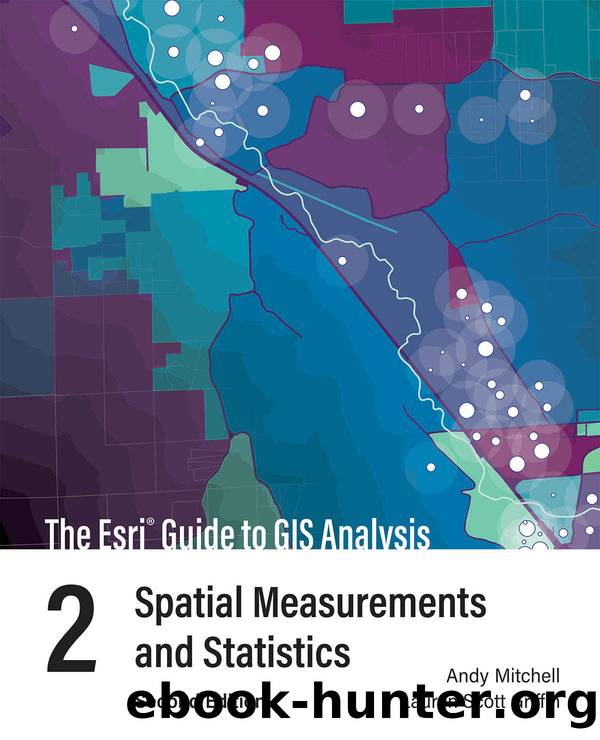The Esri Guide to GIS Analysis, Volume 2: Spatial Measurements and Statistics, second edition by Mitchell Andy & Mitchell Andy & Griffin Lauren Scott & Griffin Lauren Scott

Author:Mitchell, Andy & Mitchell, Andy & Griffin, Lauren Scott & Griffin, Lauren Scott
Language: eng
Format: epub
Tags: Technology and Engineering, Geographic Information Systems, Probability and Statistics, Spatial Analysis, Data Visualization
Publisher: Esri Press
Published: 2020-11-24T00:00:00+00:00
Testing the significance of the G-statistic
Once the GIS has calculated the observed and expected values of G, you can test whether the observed G is significantly different than the expected G (that is, significantly different than a random distribution) at a given confidence level.
The test involves calculating a z-score. First the GIS calculates the variance for the expected G. The variance represents the average amount that values differ from the mean value for all the features in the study area. Then the expected G is subtracted from the observed G and divided by the square root of the variance (that is, the standard deviation).
Transcription ZGd=Gdo-GdeSDGd Annotation: The Z-score for the G-statistic at distance (d)
Numerator: The expected G value at the distance is subtracted from the observed Gâ¦
Denominator: â¦and the difference divided by the standard deviation for the expected G for that distance
If the observed G is larger than the expected G (that is, high values are clustered), the numerator is positive and the z-score is positive. If the observed G is less than the expected G (low values are clustered), the numerator is negative and the z-score is negative.
For example, a negative z-score below the significant value (â1.96 at a confidence level of 95 percent) indicates that low values tend to be found together and you can be 95 percent sure the pattern is not due to chance. See âA Closer Look: Testing Statistical Significanceâ for more on the z-score.
With a G-statistic value higher than expected for a random distribution, and a z-score of 4.21, the clustering of high values is significant at a confidence level of 0.01 (99 percent). With a G-statistic value lower than the expected G for a random distribution (indicating clustering of low values), but a z-score of â1.26, the clustering is not statistically significant.
Download
This site does not store any files on its server. We only index and link to content provided by other sites. Please contact the content providers to delete copyright contents if any and email us, we'll remove relevant links or contents immediately.
| Historic | Information Systems |
| Regional |
Man-made Catastrophes and Risk Information Concealment by Dmitry Chernov & Didier Sornette(5901)
The Revenge of Geography: What the Map Tells Us About Coming Conflicts and the Battle Against Fate by Kaplan Robert D(4026)
Zero Waste Home by Bea Johnson(3762)
COSMOS by Carl Sagan(3539)
Good by S. Walden(3468)
In a Sunburned Country by Bill Bryson(3466)
The Fate of Rome: Climate, Disease, and the End of an Empire (The Princeton History of the Ancient World) by Kyle Harper(2988)
A Wilder Time by William E. Glassley(2805)
Camino Island by John Grisham(2749)
The Ogre by Doug Scott(2620)
Organic Mushroom Farming and Mycoremediation by Tradd Cotter(2616)
Human Dynamics Research in Smart and Connected Communities by Shih-Lung Shaw & Daniel Sui(2459)
Energy Myths and Realities by Vaclav Smil(2422)
The Traveler's Gift by Andy Andrews(2396)
9781803241661-PYTHON FOR ARCGIS PRO by Unknown(2310)
Inside the Middle East by Avi Melamed(2294)
Birds of New Guinea by Pratt Thane K.; Beehler Bruce M.; Anderton John C(2214)
A History of Warfare by John Keegan(2172)
Ultimate Navigation Manual by Lyle Brotherton(2116)
